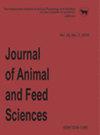Effect of tyrosine and phenylalanine supplementation on the colour and behaviour of chinchillas
IF 1.5
4区 农林科学
Q3 AGRICULTURE, DAIRY & ANIMAL SCIENCE
引用次数: 0
Abstract
The long-tailed chinchilla (Chinchilla lanigera Bennett, 1829) is native to northern Chile and can be found along the foothills of the Andes and the coastal mountains south to Talca, at an elevation of 400–1650 m. Human activities, such as poaching, hunting, grazing of cattle and goats, mining, firewood extraction, and the pet trade, have posed a significant threat to this species for years. Although legislation to protect the species has been in place since 1929, it was not efficiently enforced until the establishment of the Reserva Nacional Las Chinchillas in Auco, Chile in 1983. This species has been included in the CITES Appendix I since 1977. The current wild population is estimated at around 5350 mature individuals, and despite current protection measures, populations continue to decline, and the species is classified as endangered according to the Red List Category & Criteria (Jimenez, 1996; Roach and Kennerley, 2016). Currently, chinchillas are a popular pet and farm animal, but due to ABSTRACT. The purpose of the study was to verify whether increasing the content of tyrosine and phenylalanine in the feed would result in more intense colouration of chinchilla fur and affect the animals’ reactions to behavioural tests. Chinchillas were divided into 3 groups: G-1 fed complete commercial fodder (Tyr 6.91 mg/g, Phe 7.45 mg/g), G-2 fed commercial and experimental fodder (1:1 ratio), and G-3 fed with experimental fodder (Tyr 14.31 mg/g, Phe 21.65 mg/g). During the experiment, the fur colouration type was assessed using two methods: objective, with a colorimeter (CIE L*a*b* colour space: L* – light-dark axis, a* – red-green axis, b* – yellow-blue axis, C* – colour saturation), and subjective, by a qualified chinchilla judge. A behavioural hand test was used to categorise the chinchillas’ responses to human intrusion into their cage. The results from the colorimeter measurements did not show any significant differences in the L* (P > 0.05) component; however, significant differences were observed for the a* (P = 0.0029), b* (P = 0.0218), and C* (P = 0.0342) components in relation to the fur colouration of individual groups. The assessment of the colour type by a qualified specialist found statistically significant differences (P < 0.05) between the initial and final measurements. Spearman’s correlation coefficients between colour type assessment and colour components were mostly low or medium, but with stronger values observed for L* compared to a*, b* or C*. There were no significant effects of the feeding group on the results of the and test. However, a decreasing trend was observed in the hand test results for G-3 from week 5 of the measurements. Received: 7 September 2022 Revised: 23 March 2022 Accepted: 25 March 2022补充酪氨酸和苯丙氨酸对龙猫颜色和行为的影响
长尾栗鼠(chinchilla lanigera Bennett, 1829)原产于智利北部,可以在海拔400-1650米的安第斯山脉山麓和塔尔卡以南的沿海山脉中找到。人类活动,如偷猎、狩猎、放牧牛羊、采矿、柴火开采和宠物贸易,多年来对这一物种构成了重大威胁。尽管自1929年以来,保护该物种的立法就已经到位,但直到1983年在智利的Auco建立了Las Chinchillas国家保护区,它才得到有效执行。自1977年以来,该物种已被列入CITES附录I。目前的野生种群估计约为5350只成熟个体,尽管目前采取了保护措施,种群数量仍在继续下降,根据红色名录的类别和标准,该物种被列为濒危物种(Jimenez, 1996;Roach and Kennerley, 2016)。目前,龙猫是一种流行的宠物和农场动物,但由于ABSTRACT。这项研究的目的是验证增加饲料中酪氨酸和苯丙氨酸的含量是否会导致栗鼠皮毛的颜色更浓烈,并影响动物对行为测试的反应。试验鼠分为3组:g -1组饲喂完全商品饲料(Tyr 6.91 mg/g, Phe 7.45 mg/g), g -2组饲喂商品饲料与试验饲料(1:1比例),g -3组饲喂试验饲料(Tyr 14.31 mg/g, Phe 21.65 mg/g)。实验过程中,毛的颜色类型采用两种方法进行评估:一种是客观的,使用色度计(CIE L*a*b*色彩空间:L* -明暗轴,a* -红绿轴,b* -黄蓝轴,C* -色彩饱和度);另一种是主观的,由一名合格的栗鼠裁判进行评估。一项手部行为测试被用来对龙猫对人类进入笼子的反应进行分类。色度计测量结果显示L*组分无显著差异(P < 0.05);而a*成分(P = 0.0029)、b*成分(P = 0.0218)和C*成分(P = 0.0342)与各组毛色的关系存在显著差异。由合格的专家对颜色类型的评估发现,在初始和最终测量之间存在统计学显著差异(P < 0.05)。颜色类型评价与颜色成分之间的Spearman相关系数大多为低或中等,但L*的相关系数高于a*、b*或C*。饲喂组对试验结果无显著影响。然而,从测量的第5周开始,在G-3的手部测试结果中观察到下降趋势。收稿日期:2022年9月7日修回日期:2022年3月23日收稿日期:2022年3月25日
本文章由计算机程序翻译,如有差异,请以英文原文为准。
求助全文
约1分钟内获得全文
求助全文
来源期刊

Journal of Animal and Feed Sciences
农林科学-奶制品与动物科学
CiteScore
2.10
自引率
0.00%
发文量
42
审稿时长
3 months
期刊介绍:
Journal of Animal and Feed Sciences (JAFS, J. Anim. Feed Sci.) has been published by the Kielanowski Institute of Animal Physiology and Nutrition, Polish Academy of Sciences in Jabłonna (Poland) since 1991. It is a continuation of the Polish-language journal Roczniki Nauk Rolniczych. Seria B, Zootechniczna published by the Polish Academy of Sciences since 1969.
JAFS is an international scientific journal published quarterly, about 40 papers per year including original papers, short communications and occasionally reviews. All papers are peer-reviewed and related to basic and applied researches in the field of animal breeding and genetics, physiology of nutrition, animal feeding, feed technology and food preservation. The journal distinguishes the multidisciplinary nature of physiological and nutritional sciences and so includes papers specialized in all fields connected with animal well-being, including molecular and cell biology and the emerging area of genetics.
 求助内容:
求助内容: 应助结果提醒方式:
应助结果提醒方式:


